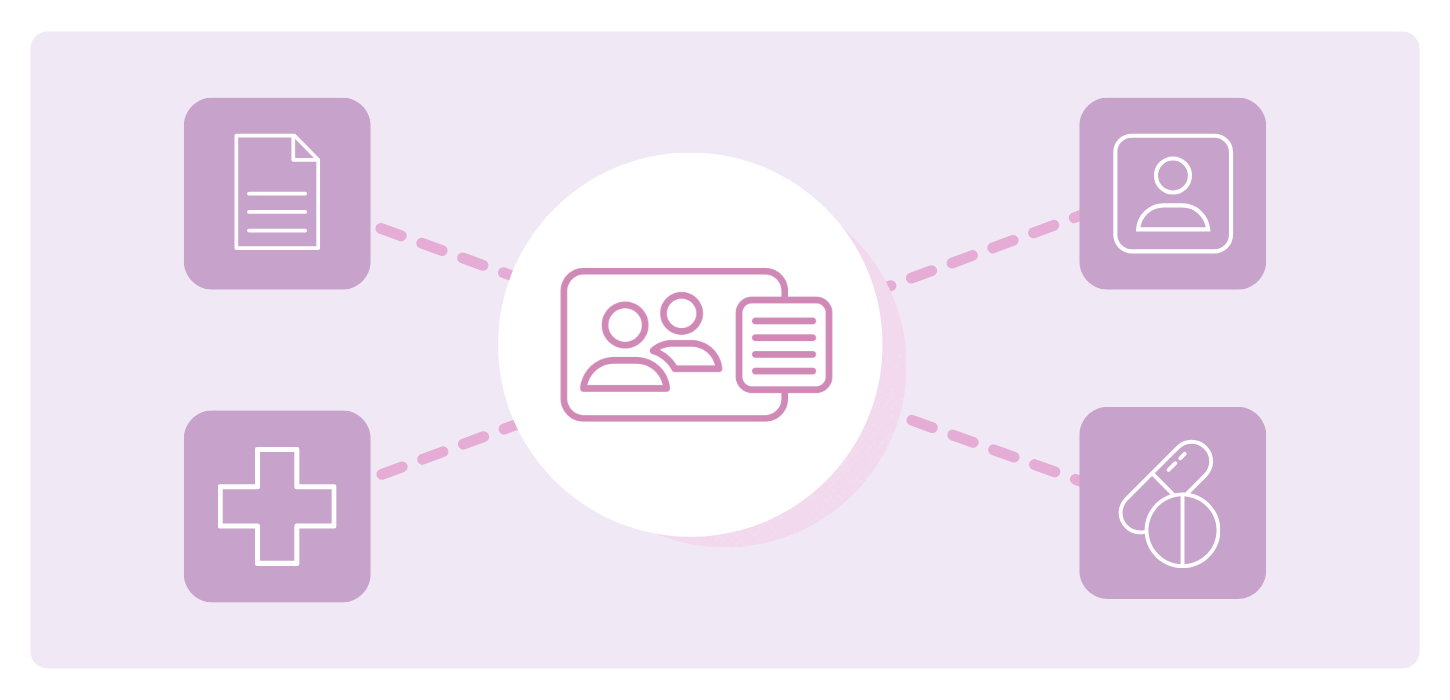At A Glance
Identity resolution unifies fragmented IDs into complete customer profiles, helping companies understand their audiences and deliver personalized, privacy-compliant experiences in a cookie-light world. With Experian’s AI-powered identity resolution solution, marketers gain the scale, accuracy, and compliance to compete while making marketing more human.In this article…
Every marketer has seen it: a customer browses reviews on a laptop, adds items to a cart on mobile, then “disappears.” In reality, they just likely switched devices or logged in with a different email. Identity resolution connects these scattered signals into a single profile so you never lose sight of the customer journey.
Identity resolution is what helps you keep track of customers who bounce around.
Connecting scattered signals into a single customer profile can help you deliver seamless experiences, meet strengthening privacy standards, turn first-party data into measurable results, and fuel better customer analytics.
See our identity resolution solution in action
What is identity resolution?
Identity resolution is the process of pulling together the different identifiers a customer uses and connecting them to a single profile. Without it, you’re left with an incomplete picture of the customer — like a cart tied to one email, an app login tied to another device, or a loyalty swipe that never links back to the same person.

Common identifiers include:
- Cookies: Short-lived browser data
- Emails: Plain-text and hashed
- Device IDs: Mobile advertising IDs (MAIDs) or app-based identifiers
- Loyalty IDs: Program numbers that tie online and offline activity
- Hashed PII: Personally identifiable information (PII) encrypted for privacy
Ultimately, identity resolution can help you recognize the same customer wherever they engage.
Why does identity resolution matter now?
Marketers face incomplete views, data silos, privacy regulations, and shrinking visibility:
- Rising consumer expectations: People want seamless, personalized journeys across touchpoints.
- Privacy-first environment: Consumer privacy legislation (like the GDPR, CCPA, GLBA, FCRA, and new state laws) makes compliance non-negotiable.
- Signal loss: The decline of cookies, MAIDs, and walled gardens are pushing brands toward first-party data.
Experian utilizes AI and machine learning to fill these gaps, predict behaviors, and connect signals across devices — providing marketers with a clear, privacy-safe view of their customers, even when traditional identifiers are missing.
In this environment, identity resolution matters because it gives marketers a way to deliver seamless, personalized customer experiences and engage audiences effectively while respecting their privacy. It’s the basis for turning consented first-party data into measurable marketing outcomes without sacrificing trust.
Why is identity resolution critical in a privacy-first world?
Even as cookies linger, marketers have already shifted their strategies to rely on first-party data, where choice and transparency are the baseline expectation. At Experian, our long history as a regulated data steward makes us a uniquely capable and trusted partner for managing modern compliance expectations. Our identity resolution solutions maximize the value of permission-based data while meeting consumer demand for privacy, personalization, and control.
Struggling with scattered customer data? Experian makes identity resolution seamless
How does identity resolution help brands?
Identity resolution turns fragmented signals into unified profiles that drive personalization, efficiency, and compliance. Here’s how it creates measurable business impact.
Creates a unified customer view
One of the biggest advantages of identity resolution is the ability to integrate data from loyalty programs, point-of-sale (POS) systems, customer relationship management (CRM) platforms, web analytics, and offline sources into a single, comprehensive profile. Experian strengthens identity resolution with AI-driven clustering models that resolve household and individual identities across billions of signals with greater accuracy.

With a clearer picture of each customer, brands see higher match rates and larger addressable audiences, which translates to more substantial reach and better return on ad spend (ROAS).
Enables better personalization
Customers constantly switch devices, update their information, and change preferences. Experian makes it easier to keep pace with these changes through frequent data enrichment and near-real-time identity resolution via Activity Feed.
Combined with our long-standing use of AI and machine learning, this approach ensures shifting behaviors are captured quickly, enabling timely personalization, and more responsive engagement.

With less delay from data to action, the result is faster response times and higher conversion rates.
Improves the customer experience
Customers notice when brands deliver relevant ads and contextual content across every channel. Consistency matters! But consistency doesn’t just happen on its own; it comes from identity resolution, which keeps the customer journey connected.

As brands maintain continuity, they build trust, strengthen engagement, and increase customer lifetime value.
Drives better marketing ROI
Not every profile is valuable. Identity resolution helps marketers identify the highest-value audiences and reduce wasted spend.

That efficiency leads to lower CPA and a higher overall ROI across campaigns.
The power of modeling from a stronger foundation
When you have a unified customer view, your models are built on better data. That means you can find more people who look like your best customers, build more responsive audience segments, and target with greater accuracy. This foundation can lead to better spending, more relevant campaigns, and a higher ROI.
Maintains privacy compliance
With GLBA/FCRA-grade standards and consumer choice mechanisms like opt-outs and data correction, you can protect your brand while maintaining personalization — without compromising legal or ethical safeguards.

What are some identity resolution use cases and examples?
Every industry faces its own unique identity challenges, but identity resolution is the common thread that turns scattered data into connected experiences. Let’s break down how companies in different verticals are putting it to work (and the kinds of results they’re seeing).
Retail and e-commerce
Shoppers bounce between websites, carts, and checkout lines, leaving behind scattered signals in the process. In retail, identity resolution bridges the gap between online and in-store experiences by matching online carts with loyalty swipes or connecting connected TV (CTV) exposure to in-store sales. This means fewer silos, better targeting, and more personalized offers wherever people shop.

Our 2025 Digital trends and predictions report calls out that omnichannel experiences aren’t optional anymore. With CTV and social dominating spend, brands need identity resolution to cut through silos and build a complete view of customer behavior.
Financial services
In financial services, identity resolution makes it possible to deliver personalized, compliant offers like refinancing options for likely mortgage switchers or the right rewards card for frequent spenders.
Our partnership with FMCG Direct to create Consumer Financial Insights® and Financial Personalities® segments helps banks, insurers, and lenders understand behaviors — such as credit card use, deposit balances, and investment habits — without exposing sensitive details.
Read more below about how our financial audiences enable privacy-safe personalization.
Travel and hospitality
Travel decisions aren’t always planned out in advance. Many bookings happen spur-of-the-moment, which is why real-time identity resolution is so powerful; it keeps the journey seamless when travelers jump from phone to laptop to tablet and presents relevant offers right as decisions are being made.
Windstar Cruises put this information into action with Experian’s identity graph to connect digital interactions with actual bookings, which drove 6,500+ reservations and $20 million in revenue.
Media and TV
Viewers tend to hop around between linear TV, streaming apps, and social feeds. And without identity resolution, every screen looks like a different person. Marketers can accurately plan, activate, and measure campaigns by unifying viewing behaviors into one ID with Experian’s AI-powered identity graph.

Optimum Media tackled its multiscreen challenge by partnering with Experian for identity solutions. Layering our audience insights and our AI-driven Digital Graph onto their subscriber data, they were able to connect the dots across channels, reach the right households, and measure results instead of just impressions. In the end, they finally got a clear view of what works across every screen.
Curious how identity resolution can power your customer analytics? We can walk you through it.
Healthcare and pharma
Healthcare marketers can’t afford slip-ups with HIPAA regulations. Identity resolution makes it possible to engage the right patients and providers with de-identified audiences rather than third-party cookies.

At Experian, AI and machine learning have always been part of how we power identity resolution. In healthcare, that means using AI-enhanced modeling to connect de-identified clinical and claims data with lifestyle insights. The result is a more comprehensive picture of the patient journey that helps close care gaps, reduce wasted spending, and improve outcomes.
By working with partners like Komodo, PurpleLab, and Health Union, we make it possible to activate campaigns at scale that boost engagement and adherence while keeping patient privacy front and center:
- Komodo Health enriches our identity graph with insights from millions of de-identified patient journeys plus lifestyle data, giving brands a fuller view of where care gaps exist and how to close them.
- PurpleLab connects real-world clinical and claims data to Experian’s platform, letting advertisers activate HIPAA-compliant audiences across CTV, mobile, and social with the ability to measure real outcomes like prescription lift and provider engagement.
- Health Union contributes a data set built from 50 million+ patient IDs and 44 billion+ patient-reported data points. Combined with our identity and modeling capabilities, this expands match rates and unlocks up to 76% net-new reach, so campaigns reach patients and caregivers in critical health moments.
As a result, healthcare brands can launch campaigns that are privacy-first, highly targeted, and proven to drive meaningful impact.
Audio
People use audio while commuting, working out, and even folding laundry. It can be one of the hardest channels to track because of how frequently listeners switch between apps, stations, and devices.

Experian’s identity resolution partnerships with Audacy and DAX change the game:
- Audacy helps tie scattered listening into a single view, so advertisers can follow audiences across devices and keep ads relevant in the moment.
- DAX pairs Experian’s 2,400+ syndicated audiences with its audio network, enabling brands to target precisely and launch impactful campaigns at scale.
These partnerships turn audio into an accurate channel where ads feel personal, privacy-safe, and measurable.
Gaming
Gamers don’t stick to one platform. Player data gets scattered across mobile, console, and PC, so it’s tough to keep track of individuals. Experian helps stitch those signals together so publishers can finally see the whole picture, personalize gameplay, and keep players coming back.
With enriched profiles, publishers can deliver offers that resonate and unlock fresh revenue by packaging high-value gaming audiences for advertisers outside the industry.
Unity, a leading gaming platform, is tapping into Experian’s syndicated audiences to gain player insights and help advertisers reach gamers across mobile, web, and CTV. For global publishers, unifying player data with Experian has driven higher engagement and stronger ad ROI.
How should I evaluate identity resolution providers?
When choosing an identity resolution partner, look for:
- Data scale and quality: The value of identity resolution depends on how complete and accurate the underlying data is. The right provider should bring together a wide range of identifiers from online and offline sources, maintaining high accuracy so your customer profiles are broad and reliable.
- Match accuracy and recency: The best partners also refresh their data regularly and can blend deterministic (exact, one-to-one matches) with probabilistic (pattern-based matches) methods. That way, you get the accuracy of “this email is definitely that customer” with the reach of “this device likely belongs to the same person.”
- Privacy and compliance readiness: Compliance can’t be an afterthought. Your identity partner should be ready for GLBA, FCRA, GDPR, CCPA, and the latest state-level rules with built-in tools for opt-outs, corrections, and deletions.
- Integration flexibility: A good provider fits into your world, not the other way around. Look for pre-built integrations with your customer data platform (CDP), demand-side platform (DSP), or marketing tech (MarTech) stack so you can get up and running without the heavy IT lift.
- Data analytics capabilities: You need proof that identity resolution drives ROI. Look for closed-loop measurement that ties unified IDs directly to campaign performance, so you can see what’s working and optimize with confidence.
How Experian enables enterprise-grade identity resolution
Experian delivers identity resolution at the scale, accuracy, and compliance required by the world’s largest enterprises. Our solutions are:
- Built on trust: Backed by 40+ years as a regulated data steward and rated #1 in data accuracy by Truthset, so you can act with confidence.
- Powered by our proprietary AI-enhanced identity graph: Combining breadth, accuracy, and recency across four billion identifiers, continuously refined by machine learning for maximum accuracy.
- Seamlessly connected: Pre-built data integration with leading CDPs, DSPs, and MarTech platforms for faster time to value.
- Always up to date: Frequent enrichment and near-real-time identity resolution through Activity Feed for timely personalization and more responsive customer engagement.
- Privacy-first by design: Compliance with GLBA, FCRA, and emerging state regulations baked in at every step, supported by rigorous partner vetting.
The bottom line
Identity resolution turns fragmented signals into connected, measurable, and compliant experiences. From retail to gaming, brands using it see stronger personalization, engagement, and ROI.
With Experian, you get the data, trust, and responsible AI innovation to make identity resolution work across every channel. Our approach uses AI to connect identities, predict behaviors, and deliver personalization that balances privacy with performance. If you’re ready to turn fragmented data into growth, now’s the time to start.
The world’s leading brands trust us to power identity resolution at scale. See how we can do the same for you.
Identity resolution FAQs
Deterministic uses exact identifiers (like an email) for accuracy, while probabilistic uses signals and algorithms to expand reach. Best-in-class providers usually combine both.
Identity resolution helps with personalization by unifying scattered signals into one profile. It reduces wasted spend and increases match rates, which means bigger addressable audiences and higher ROAS.
Yes. With first-party data and hashed PII, brands can still maintain addressability and personalization.
Retail, finance, travel, media, gaming, and audio all use identity resolution to personalize, attribute sales, and improve efficiency.
A customer data platform unifies the data you already own. Meanwhile, we add depth, scale, and higher match rates by layering in our identity graph and data enrichment.
Yes. Experian is GLBA/FCRA compliant, GDPR/CCPA ready, and supports consumer opt-outs and corrections to ensure responsible personalization.
Latest posts

In this article…The growth of CTV in political advertisingBenefits of CTV over traditional TV advertising for political campaignsChallenges and considerations for advertisersLooking ahead: CTV in the 2024 elections Political advertising has advanced significantly in recent decades. Historically, campaigns had limited options for where they could advertise, and those channels had limited inventory. Political campaigns primarily relied on radio, print, and linear TV to reach voters, using mass marketing strategies to appeal broadly to unspecified audiences. These mediums had limited targeting capabilities and provided few data insights. However, this has all changed thanks to the rise of technology and changing media consumption habits. With the advent of the internet and the emergence of various digital channels, political campaigns now have more inventory and options for getting their message out there, including connected TV (CTV) — a subset of advanced TV that has become a predominant channel for digital ad spend. CTV is the fastest-growing medium for political ads, with the upcoming 2024 election expected to see $1.5 billion in CTV marketing ad spend (nearly half of all political digital advertising dollars!). CTV’s share of political ad spending is set to jump from 2.7% in 2020 to 12.8% this year. The Harris campaign is leading the charge, allocating $200 million for digital ads, much of which will go to streaming platforms. CTV advertising promises to be an effective method for political campaigns trying to reach voters with personalized content in 2024. Let’s look at CTV political ads a little closer and overview the implications for your political campaign. The growth of CTV in political advertising CTV has become central to political ad strategies in helping campaigns gain exposure through targeted, personalized ad experiences to specific audience segments based on demographics, behaviors, and interests. With CTV advertising, political campaigns have become more adaptable to changing viewer preferences and can ensure their messages resonate with diverse audiences across digital platforms. This strategy represents a critical opportunity for political campaigns to tap into the growing viewership of streaming and adjust their marketing plans to meet voters where they spend their time. Although traditional broadcast TV remains at the forefront of political advertising, recent increases in CTV political ad spending in 2024 reflect shifting media consumption preferences toward streaming services. Today, the average American adult spends almost 2 hours per day on CTV devices. It’s worth noting that CTV has the most significant audience share with Millennials, which makes CTV an especially worthy investment for targeting the younger generations whose voting habits aren’t as established yet. 2024 political ad spending Compared to the previous U.S. presidential election year in 2020, campaigns and interest groups are expected to increase their political ad spending promoting causes and candidates by almost a third in 2024, totaling approximately $12.32 billion, according to Reuters. This is said to encompass all advertising for federal, state, and local politics, including lobbying and election activities. While traditional media still dominates political ad spending, digital platforms are growing, with 45% of digital ad spending projected to be allocated to CTV for its refined targeting capabilities and increased inventory in this election cycle. For reference, only 19% of digital political ad spend went to CTV in 2020. While the presidential election tends to garner the most attention among voters, it's essential to note that political ad spending goes well beyond the big race; over 500 seats are up for election in 2024. Down-ballot races and issues in state and local elections will significantly impact where ad dollars are allocated. Experian’s relevant ballot initiative audiences If you’re looking to reach voters based on their attitudes and behaviors around crucial ballot measures, Experian offers over 240 politically relevant audiences that can help. Our consumer behavior and interest audiences can fine-tune your targeting for local and national ballot initiatives if, for example, you were targeting military families who favor initiatives supporting veterans or households with children interested in supporting school funding. This precise targeting ensures your political ads reach the most receptive audiences and maximizes the impact of your ad spend. Third-party cookie deprecation and CTV The phase-out of third-party cookies has created a challenge for political campaigns relying on digital advertising strategies. In the past, political advertisers have used cookies to track a user’s web activity to understand their browsing behaviors across sites and create detailed profiles for targeting purposes. However, due to recent changes in online privacy regulations, third-party cookies are going away. Political advertisers have recognized the need for innovation and are exploring new avenues for effectively reaching target audiences without third-party cookies. CTV has arisen as a promising solution, as it doesn’t rely on these cookies to paint a picture of audiences and offers an alternative for precise, privacy-compliant targeting and ad spend optimization. CTV publishers tend to know quite a bit about audiences, including their viewing habits, location, preferred CTV devices, and more — and utilizing this information can give your campaign deeper, more accurate data without invading user privacy. Benefits of CTV over traditional TV advertising for political campaigns CTV political ads are a great way to familiarize a candidate’s core audiences with their message and engage them with the campaign. Here are some specific ways a political campaign can benefit from CTV in its advertising strategies. Broadened access to data Traditional broadcast and cable TV are a means of one-way communication. This means viewers consume broadcasted content without direct interaction or a feedback loop for tracking engagement and behavior data. CTV solves the limitations of traditional TV by offering access to more data than linear TV using technology and internet connectivity to gather real-time insights. CTV data on audience interactions, preferences, demographics, behaviors, location, income, and more enable precise targeting and tailored messaging for more impactful campaigns. Furthermore, digital infrastructure enables CTV devices to track clicks, ad impressions, and conversions, which marketers can use to understand interests, viewing habits, and audience demographics more effectively. To sum it up, CTV broadens the scope of data available for political campaigns to refine their targeting. Targeted, personalized ad experiences With traditional TV advertising, marketers have historically had to rely on mass marketing strategies, broadcasting ads to a general audience and hoping to reach the right demographic segments. This imprecise approach limits a marketer’s control over who sees their ads and wastes time and money. In contrast, CTV platforms can collect abundant data on viewer behavior, preferences, and demographics, helping advertisers precisely target audiences and reach groups most likely to benefit from the ads. With CTV, advertisers can segment audiences based on gender, age, interests, location, and past viewing behavior. This level of granularity enables them to customize their messages to resonate with specific people and increase the relevance and effectiveness of their political ad campaigns. By delivering ads to the right groups of people at the right time, CTV helps advertisers maximize campaign impact and drive better results. It’s worth noting that streaming viewership is beginning to change. Although younger generations have engaged the most with CTV, there is research to show that older generations are starting to help fuel its continued growth. Gen X and Baby Boomers have begun to embrace streaming and seek out ad-supported services to ad-free alternatives. These gradual shifts in behavior highlight the importance of understanding streaming generations to reach target audiences effectively. Real-time ad campaign optimization While traditional TV relies on fixed ad placements, CTV offers programmatic buying, which refers to buying and selling ad placements on CTV through automated technology. Programmatic CTV advertising is highly data-driven, which gives advertisers flexibility in their messaging strategies, helps them refine their targeting, and deliver relevant ads to the right people at the right time. With real-time analytics, campaigns can monitor ad performance, adapt to changing circumstances, and make data-driven decisions to maximize advertising impact and budget efficiency leading up to the election. Challenges and considerations for advertisers Despite how widely beneficial CTV advertising can be for political campaigns, marketers also need to be aware of its limitations. Navigating ad fraud Ad fraud is a major problem for unsuspecting advertisers. CTV ad fraud involves fake CTV devices or bots mimicking viewership and cheating marketers into paying for unviewed or non-existent ad placements. According to DoubleVerify’s Global Insights, CTV bot fraud increased nearly 70% in 2022 compared to the previous year, with CTV fraud instances tripling since 2020. In 2023, digital ad fraud cost the marketing industry $84 billion. These ad fraud schemes are rising due to the high CPM of CTV ads, leading to a bigger payout for fraudsters who steal ad dollars. One of the primary challenges is the need for better technological safeguards to detect and mitigate illegitimate traffic, such as bot activity. Political advertisers often rely on third-party ad fraud and verification technologies to avoid falling victim, but these solutions cannot guarantee complete protection. This usually leaves advertisers unaware of fraudulent activities until they’ve already incurred financial losses. As political campaigns increasingly embrace CTV political ads, they become bigger targets for fraud and must make protection and measurement central to validating their campaign efficacy in conjunction with robust fraud detection measures. These efforts can help protect the integrity of political ad campaigns, mitigate fraud, and ensure messaging reaches genuine voters. Ensuring ad effectiveness Measurement and attribution of CTV political ads can be challenging. CTV offers better insights into audience preferences and behavior than linear TV, but despite the existing measurement tools, CTV is fragmented, involves many platforms, and lacks standardized metrics and attribution models tailored to political campaign goals. These problems make it hard to compare campaign performance, track CTV users across their viewing experience, and ensure ads appear in the right environments. To fully understand your ad effectiveness, you should ensure accurate tracking mechanisms of audience behaviors with individual ads to assess the impact of CTV campaigns on voter engagement and turnout. This will help you better understand how to achieve campaign objectives, where to focus your efforts, and how to appeal to viewers in future campaigns. It may also be helpful to understand some of the metrics advertisers currently employ for CTV measurement, including completion rate and return on ad spend (ROAS). Because CTV ads often can’t be skipped, this advertising strategy has a high completion rate, sometimes nearing 90%. ROAS is more focused on what you get in return for your ads, allowing you to track profits per dollar spent on ads. Political marketers can also use metrics like campaign impressions, total reach, view-through rate, and cost per completed view to understand how their ads are performing. Ethical considerations related to transparency and misinformation Political advertisers are responsible for upholding transparency and accuracy in their messaging to build trust with voters. Given how polarized the current political climate is, misinformation could make or break a political campaign. Whether intentional or unintentional, spreading misinformation through CTV can undermine the democratic process and erode public confidence in political institutions. Political marketers must do their best to prioritize ethical conduct, adhere to regulatory guidelines, and ensure their ads convey truthful information to voters. Looking ahead: CTV in the 2024 elections The current election cycle promises record-breaking political ad spending in 2024 and will underscore CTV's role in shaping the future of political communication and engagement. With shifting viewer preferences and the ongoing evolution of digital media consumption habits, political campaigns need to look at CTV as a critical platform for voter engagement so they can allocate resources and shift their strategy to harness its full potential. Using the targeted capabilities and expansive reach CTV advertising offers, political entities can optimize ad creative for the streaming environment, implement data-driven targeting strategies, and effectively connect with voters across diverse demographics and geographic regions. Reach your ideal voters with Experian’s political audiences Effective audience targeting is essential for political campaigns wanting to sway voters and shape public opinion in the next election. Don't miss the opportunity to reach your ideal voters and make a lasting impact in the 2024 elections! With Experian’s political audiences, you can target voters based on their political affiliations, personas, and attitudes toward relevant ballot initiatives in your advanced TV advertising. Experian offers a comprehensive range of political and geo-indexed audiences designed to help political campaigns and organizations connect with desired segments in a meaningful and impactful way. Our geo-indexed audiences can help you discover, segment, and craft messaging without the use of sensitive personal information, so you can confidently reach your target audience without sacrificing data privacy. Our syndicated audiences also span multiple verticals and categories. With over 240 politically relevant audience segments available for activation, you can confidently execute your political campaign marketing strategy with precision and impact. When you connect with our audience team, we can also help you build and activate an Experian audience on the platform of your choice. Partner with us to reach your ideal voters and make a lasting impact in the 2024 elections. Get started Latest posts

In this article… In this article… In this blog post…What is political campaign marketing?Benefits of digital marketing in political campaignsExperian's political personasHow to combine our political personas with other audiences In the American political landscape, understanding the intricacies of voters' attitudes and behaviors has never been more crucial. With the 2024 election season on the horizon, the challenge lies in moving beyond broad categorizations like "Democrat," "Republican," or "Independent." Voters seek candidates who resonate with their beliefs and values. To meet this challenge, Experian has created political personas that offer a nuanced understanding of American voters. In this blog post, we’ll explore how these Experian audiences can help you tailor your engagement strategies for the upcoming election cycle. Before we dive into our political personas, let's break down what political campaign marketing is and six benefits of using digital marketing in political campaigns. What is political campaign marketing? Political campaign marketing is the strategic engine that drives candidates toward electoral success. It involves crafting and sending out tailored messages to effectively reach constituents to inform them about candidates’ stances on key issues. Think of it as the art of narrative construction, using various communication channels—from traditional media to digital platforms—to engage and mobilize supporters. In an era marked by information saturation, effective campaign marketing serves to cut through the noise to deliver compelling messages that inform, inspire, and spur action. Benefits of digital marketing in political campaigns As the 2024 election approaches, using digital marketing in political campaigns becomes paramount to effectively reach and influence voters where they spend a significant portion of their time—online. Kamala Harris's entry into the race has shifted spending priorities, particularly in critical states such as Ohio, where the Senate race has already attracted $300 million in ad spending. Political ad spend on connected TV (CTV) is expected to rise significantly, from 2.7% in 2020 to 12.8% this year. The Harris campaign is spearheading this trend, dedicating $200 million to digital ads, with a substantial portion directed toward streaming platforms. Embracing digital marketing can help campaigns effectively shape opinions and mobilize support. Here are five key benefits of integrating digital marketing strategies into political campaigns: Unparalleled reach with targeted advertising: A well-connected digital platform partner can help you reach your target audiences across the ecosystem – from social to the open web. Optimization flexibility: Digital marketing allows for quick adjustments in response to real-time data and evolving circumstances. Interactive engagement: The interactive nature of digital channels creates meaningful engagement and dialogue between candidates and voters, building connections and community. Insights: Robust analytics provide valuable insights into audience behavior and preferences, facilitating continuous optimization and refinement of outreach efforts. Amplified messaging: Through digital marketing, political campaigns can amplify their message, mobilize support, and forge deeper connections with voters. Data serves as the foundation for these benefits. Interactivity hinges on data to deliver the right message and creative for engagement. Insights are gained through pre-campaign research, analyzing audience attributes to grasp their interests and behaviors. Flexibility relies on real-time campaign data, a unique advantage in digital marketing. In an era where audiences are available readily on most major activation platforms, advertisers need to understand how audiences are built to be privacy conscious and consistent in a cookieless environment. Experian’s political personas Digital marketing in political campaigns is crucial to reach and influence voters online. Integrating Experian's political personas into your political campaign strategy can help you grasp the complexities of today's American voter landscape and craft tailored engagement strategies. These personas offer invaluable insights into voter viewpoints on key political issues, enriching digital marketing efforts and empowering campaigns to connect with constituents more effectively. Experian has created 10 political personas to help you better understand today’s American voter so you can reach consumers based on their viewpoints into key political issues. Our political personas group voters along the political spectrum from most “committed” on the ends of the spectrum. Let’s walk through how we define each persona starting from the most “committed” personas on the ends of the spectrum. Committed Democrats This audience contains consumers who are likely to have a "very liberal” outlook on political issues. They have strong liberal opinions on various topics including key issues and the economy and are very involved in their communities. Committed Republicans This audience contains consumers who are likely to have a "very conservative” outlook on political issues. They are well-informed, community-minded individuals with strong opinions that reflect their conservatism. They have very conservative attitudes regarding key social issues. Moderate Democrats This audience contains consumers who are likely to have a “somewhat liberal” outlook on political issues. Moderate Republicans This audience contains consumers who are likely to have a “somewhat conservative” outlook on political issues. Political Leaning Liberals This audience contains consumers who are likely to have strong opinions on key issues that may not align with the traditional Democrat point of view. Political Leaning Conservatives This audience contains consumers who are likely on-the-fence on traditional Republican points of view on key issues. Liberal Leaning Independents This audience contains consumers who are registered independents and who are likely to have a “middle of the road” outlook on political issues while tending to lean more liberal. Conservative Leaning Independents This audience contains consumers who are likely registered independents and likely have a "middle-of-the-road” outlook on political issues while tending to lean more conservative. Political Unregistered Liberal Leaning This audience contains consumers who are not likely to have aligned with a specific party, but have a more liberal attitude. They are well-informed and are aware of important political issues. They frequently align with but are not necessarily completely aligned with liberal points of view. Political Unregistered Conservative Leaning This audience contains consumers who are not likely to have aligned with a specific party, but have a more conservative attitude. They are well-informed and are aware of important political issues. They frequently align with but are not necessarily completely aligned with conservative points of view. These 10 personas can help you better understand who the American voter is, but when combined with our 200 politically relevant audiences, such as watches political TV, donations to charitable causes, engagement channel preferences, hobbies, and more, the ability to study and improve engagement for each persona is considerably magnified. How to combine our political personas with other audiences If you're a political candidate looking to reach an important population, Experian audiences are available on-the-shelf of major platforms. For example, if you want to reach unregistered voters and independent voters to influence green initiatives within your community, you can focus on unregistered and moderate personas in the area and combine that with audiences interested in green initiatives, like our GreenAware segments – which predict a consumer’s attitude and point of view on environmental issues. You can use our "Political Unregistered Liberal Leaning", "Liberal Leaning Independents," and GreenAware “Think Greens” audience segments to reach constituents who are likely to be most interested in your message. To reach voters based on their regional voting patterns, you can use our new battleground counties and district audiences: Affiliation Switcher Counties Battleground Counties House Battleground Districts Democrat Counties Republican Counties Independent Counties Add Experian’s audiences to your 2024 election strategy Political advertising spend is projected to surpass $12 billlion in the 2024 election cycle, generating the largest amount of voter outreach in the history of American elections. Experian’s audiences are available on major activation platforms allowing you to strategically reach constituents who would be most impacted and interested in your initiatives. As we approach a cookieless future, Experian’s political personas are cookie resilient. Our data is rooted in both offline and online data that doesn’t rely on third-party cookies. The personas do not rely on an individual’s browsing behavior. Experian can help our partners understand and engage with these political audiences. Over 200 politically relevant Experian audiences are available for activation on-the-shelf of the leading TV, demand, and supply platforms. Here are the platforms where you can find our political audiences: ArcSpan Audigent Cadent Eyeota Magnite Microsoft Nexxen Pandora Permutive Samsung Ads The Trade Desk Verizon Media Viant Videoamp Yieldmo Can’t find the audience you’re looking for or need a custom audience? Connect with our audience team for more information. Connect with our audience team Contact us Latest posts

As audiences shift from linear TV to streaming and digital platforms, measurement is becoming more complex and critical. In 2024, brands that can unify impressions across channels, resolve identity, and connect measurement to business outcomes will gain a significant advantage. Here’s what advertisers and platforms need to know. Why TV measurement is under pressure One name has long stood as the bedrock in TV measurement: Nielsen. Nielsen Nielsen is a leading provider of TV audience measurement and analytics. It is known for its TV rating system, which tracks viewership across various demographics and time slots. Nielsen’s data is used by media companies, advertisers, and broadcasters to understand audience preferences, develop, and plan advertising campaigns, and monitor program performance. Nielsen’s recent global expansion Nielsen has continued to expand its global coverage and now fully represents 100% of TV households in the continental U.S., delivering comprehensive and accurate audience measurement. Through this expansion, Nielsen has remained a go-to resource for domestic and international television analytics. In 2021, Nielsen faced a significant setback when it was stripped of its MRC (Media Rating Council) accreditation, sending shockwaves through the industry. While the accreditation was eventually reinstated in 2023, the incident underscored the need for diversification and alternatives within TV measurement. TV measurement competitor outlook For decades, advertisers and agencies have relied on Nielsen's metrics as the gold standard, a trusted source of data guiding ad spending and campaign strategies. However, recent developments have shaken this foundation, prompting a reevaluation of the TV measurement landscape. One notable trend emerging in TV measurement in 2024 is the increasing interest in alternative measurement providers. As advertisers seek greater transparency, accuracy, and flexibility in measurement, many are exploring options beyond Nielsen. These providers offer distinct advantages and drawbacks, presenting advertisers and agencies with a wealth of options and considerations. Panel-based TV measurement providers Panel-based TV measurement has long been a staple in the industry, relying on representative samples of viewers to extrapolate audience behavior. In 2024, several providers offer panel-based solutions, each with different strengths. Comscore Comscore is a key player in panel-based TV measurement, offering comprehensive audience measurement solutions for both linear and digital television. With its massive panel of opted-in households, Comscore provides advertisers with detailed demographic and behavioral insights, enabling targeted advertising strategies. Comscore recently earned MRC accreditation for total household and average audience measurement in national and local TV reports. Kantar Media Kantar Media offers a range of panel-based TV measurement services, including audience measurement, ad effectiveness measurement, and competitive intelligence. With its global footprint and deep expertise in media analytics, Kantar Media helps advertisers understand audience trends and optimize their media investments. Kantar Media is currently working to create a cross-media measurement panel similar in size to what Nielsen offers. While Kantar Media does not presently operate in the U.S. TV measurement market, it would be a formidable competitor should it move into the arena. ACR-based TV measurement providers Automatic content recognition (ACR) technology has revolutionized TV measurement, allowing for real-time monitoring of content consumption across devices. In 2024, several providers use ACR technology to deliver innovative measurement solutions. iSpot.TV iSpot.TV has emerged as a leading provider of ACR-based TV measurement, using its advanced technology stack to capture and analyze TV ad exposures in real-time. Through its acquisition of 605, iSpot.TV strengthens its position in the market, offering advertisers enhanced audience targeting and attribution capabilities. iSpot.tv’s ad catalog and ad occurrence data are fully accredited by the MRC, which is one of its strongest assets. Watch our Ask the Expert with 605 here Samba TV Samba TV offers a comprehensive ACR-based TV measurement platform, providing advertisers with insights into audience behavior across linear, streaming, and connected TV environments. With its robust data infrastructure and machine learning algorithms, Samba TV enables advertisers to optimize their TV advertising campaigns for maximum impact. Samba has recently partnered with HyphaMetrics to create an alternative panel to compete with others in the market. TVision TVision is a smaller competitor in this group that blends ACR-based TV measurement solutions with a panel-based approach, offering advertisers and networks real-time visibility into viewer engagement and attention metrics. By tracking viewer attention and emotional response, TVision helps advertisers understand the effectiveness of their TV ad campaigns and make data-driven decisions. Four common misconceptions in CTV advertising Advantages of alternative measurement providers As the TV measurement landscape evolves in 2024, alternative providers present compelling advantages over traditional approaches, with three key benefits to consider. Diverse data sources: Alternative providers use a wide array of data sources, including set-top boxes, smart TVs, streaming platforms, and digital devices, offering a more comprehensive view of audience behavior. Granular insights: Many alternative providers offer granular insights into viewer demographics, preferences, and engagement metrics, allowing for more targeted and effective advertising strategies. Real-time analytics: Some providers deliver real-time insights that let advertisers optimize campaigns on the fly and quickly act on emerging trends. Learn how our Digital Graph creates a unified view across TV and digital Challenges with alternative measurement providers Alternative providers face several key challenges that need to be addressed before they are widely adopted. Let's dive into each challenge in more detail. Fragmentation With multiple providers using different methodologies and metrics, achieving standardization and comparability across campaigns can be a daunting task. With the proliferation of over-the-top (OTT) services, the TV measurement landscape has become increasingly complex, with new platforms emerging regularly. While ACR technology has enhanced data collection directly from televisions, the market remains highly fragmented, with many manufacturers (like Vizio, LG, and Samsung) building their own ACR solutions. We've teamed up with both LG and Samsung to make our identity and audience solutions available directly within their platforms, enhancing targeting, activation, and measurement capabilities for advertisers in the CTV space. Data privacy concerns As TV measurement becomes increasingly data-driven, concerns around consumer privacy and data ethics loom large, necessitating robust privacy protocols and compliance measures. We’ve already seen lawsuits around the ACR approach to TV measurement. Education and adoption Shifting away from the familiar territory of Nielsen requires education and buy-in from stakeholders, including advertisers, agencies, and media buyers, which can be a gradual and iterative process. See how we help Optimum Media connect every screen to real results Next steps for an identity graph in TV measurement As the TV measurement landscape trends toward a blend of options instead of singular approaches, the ability to identify and target audiences across platforms is crucial. An identity graph serves as a foundational tool that can enable brands and advertisers to resolve disparate data sources into a unified view of the consumer. Experian’s Digital Graph includes more than 4 billion digital identifiers in the U.S., such as mobile ad IDs (MAIDs), universal IDs, connected TV (CTV) IDs, third-party cookies, and hashed emails (HEMs). Representing 250 million individuals and 275 million CTV IDs, it helps advertisers maintain consumer connections as signals fade. Our ability to merge offline and digital data delivers stronger ID resolution, cross-channel attribution, and clearer insights into audiences across streaming, linear, and digital environments. And because identity is only as powerful as the activation it enables, Experian’s data marketplace makes these audiences directly addressable across TV platforms. Advertisers can seamlessly activate custom audience segments for CTV, streaming, and linear partners – all while maintaining the same identity foundation across planning, targeting, and measurement. As advertisers navigate the complexities of the TV measurement landscape in 2024, combining Experian’s Digital Graph, Offline Graph, and data marketplace will be essential for building effective cross-channel advertising strategies and maximizing ROI. Learn how our Digital Graph strengthened MiQ's Identity Spine How Experian supports TV measurement Experian has been in the TV measurement space for decades and offers flexible attribution reports that can attribute media spend on TV to real actions or outcomes, such as website visits, physical location visits, and online and offline sales. We also have unique data through our automotive and financial databases that can be used for attribution. Through our Consumer Sync solutions, you can elevate your attribution quality to understand the true path to conversion by linking all digital touchpoints to a single person. The next frontier of TV measurement TV measurement in 2024 presents both challenges and opportunities for understanding audience behaviors and preferences. We anticipate a continued migration toward alternative providers as advertisers seek greater flexibility and accuracy in measurement. We expect a fragmented future for TV measurement, where data sources extend beyond traditional giants like Nielsen to include numerous smaller players. Despite the entrenched role of linear TV measurement, advertisers must adapt to a blend of data from diverse sources to navigate the evolving landscape. Read our playbook on how to capture future buyers on FAST At Experian, we have the solutions to help you tackle 2024 marketing trends and make the most of your consumer marketing data. Our Graph enables seamless tracking across devices and channels, allowing us to implement first-touch, last-touch, and multi-touch attribution models with unparalleled accuracy. By harnessing the capabilities of our Graph, our attribution solutions can assign value to every crucial touchpoint in the customer journey, giving you a more holistic and comprehensive view of your campaign performance. Connect with an Experian expert to learn more about how we can help you succeed in your marketing efforts. Connect with us today Latest posts FAQs What is TV measurement? TV measurement is the process of tracking how viewers consume content across linear, streaming, and connected TV (CTV), and connecting those impressions to advertising outcomes. Who is TV measurement designed for? TV measurement is built for advertisers, agencies, media owners, and platforms that need to understand reach, frequency, and ROI across fragmented TV and digital ecosystems. What types of TV measurement solutions exist today? There are panel-based providers (like Nielsen and Comscore), ACR-based providers (like iSpot.TV, Samba TV, and TVision), and hybrid or identity-based approaches that unify signals across channels. How do alternative providers ensure accuracy and performance? Many rely on diverse data sources (set-top boxes, smart TVs, streaming platforms) and identity graphs to improve match rates, reduce duplication, and deliver a more complete view of audiences. Is TV measurement privacy-compliant? Yes. Leading providers, including Experian, build privacy and compliance into their solutions. What makes Experian’s approach different from other providers? Experian uniquely combines offline and digital data within its identity graph, enabling precise ID resolution, cross-channel attribution, and outcome-based measurement that connects media spend to real actions. Where can I learn more or get started? You can explore Experian’s measurement solutions or connect with an Experian expert for a personalized walkthrough.